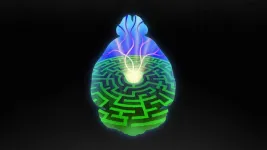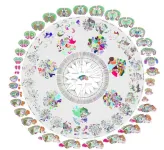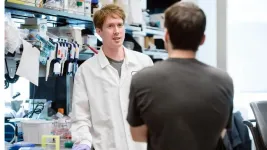(Press-News.org) PHILADELPHIA— New research reveals that neurons in the preoptic hypothalamus—the region of the brain that regulates sleep and body temperature—are rhythmically activated during non-rapid eye movement sleep (NREM). Stress activates these brain cells out of turn, causing “microarousals,” that interrupt sleep cycles and decrease the duration of sleep episodes, according to research from Perelman School of Medicine at the University of Pennsylvania, published today in Current Biology.
While our bodies are at rest when we are asleep, our brains are still very active during four different stages of sleep. In each 90-minute sleep cycle, there are three stages of NREM sleep, and one stage of rapid eye movement (REM) sleep. During the first two stages of NREM sleep, brain waves, heartbeat, and breathing slow, and body temperature decreases. Stage two also includes unique brain activity, called spindles and K-complexes, which are short bursts of activity responsible for processing outside stimuli, as well as for consolidating memory. Stage three of the NREM sleep cycle is when the body releases growth hormone, which is important for repairing the body, keeping the immune system healthy, and further improving memory. During phase three, brain waves are larger, called delta waves. REM sleep, which happens in this phase when dreaming normally occurs, is also critical for memory formation, emotional processing, and brain development.
“When you have a bad night of sleep, you notice that your memory isn’t as good as it normally is, or your emotions are all over the place—but a bad night of sleep interrupts so many other processes throughout your body. This is even more heightened in individuals with stress-related sleep disorders,” said senior author, Shinjae Chung, PhD, an assistant professor of Neuroscience. “It’s crucial to understand the biology driving the brain activity in these crucial stages of sleep, and how stimuli like stress can disrupt it, so that we might someday develop therapies to help individuals have more restful sleep that allows their brain to complete these important processes.”
The researchers monitored the activity in the preoptic area (POA) of the hypothalamus of mice during their natural sleep and found that glutamatergic neurons (VGLUT2) are rhythmically activated during NREM sleep. They also found that VGLUT2 neurons were most active during wakefulness, and less active during NREM and REM sleep.
During microarousals in NREM sleep, VGLUT2 neurons were the only active neurons within the POA, and their signals started to increase in the time before a microarousal. To confirm that active VGLUT2 neurons were indeed the cause of microarousal, the researchers stimulated the VGLUT2 neurons in sleeping subjects, which immediately increased the amount of microarousals and wakefulness.
Next, to illustrate the connection between stress and increased VGLUT2 neuron activation, researchers exposed subjects to a stressor, which increased awake time and microarousals, and decreased overall time spent in REM and NREM sleep. Researchers also noted increased VGLUT2 neuron activity during NREM sleep in the stressed subjects. What’s more, when researchers inhibited VGLUT 2 neurons, microarousals during NREM sleep decreased, and NREM sleep episodes were longer.
“The glutamatergic neurons in the hypothalamus give us a promising target for developing treatments for stress-related sleep disorders,” said first author, Jennifer Smith, a graduate researcher in Chung’s lab. “Being able to reduce interruptions during the important stages of non-REM sleep by suppressing VGLUT2 activity would be groundbreaking for individuals struggling with disrupted sleep from disorders like insomnia or PTSD.”
This research was supported by the National Institute of Neurological Disorders and Stroke (R01NS110865).
###
Penn Medicine is one of the world’s leading academic medical centers, dedicated to the related missions of medical education, biomedical research, excellence in patient care, and community service. The organization consists of the University of Pennsylvania Health System and Penn’s Raymond and Ruth Perelman School of Medicine, founded in 1765 as the nation’s first medical school.
The Perelman School of Medicine is consistently among the nation's top recipients of funding from the National Institutes of Health, with $550 million awarded in the 2022 fiscal year. Home to a proud history of “firsts” in medicine, Penn Medicine teams have pioneered discoveries and innovations that have shaped modern medicine, including recent breakthroughs such as CAR T cell therapy for cancer and the mRNA technology used in COVID-19 vaccines.
The University of Pennsylvania Health System’s patient care facilities stretch from the Susquehanna River in Pennsylvania to the New Jersey shore. These include the Hospital of the University of Pennsylvania, Penn Presbyterian Medical Center, Chester County Hospital, Lancaster General Health, Penn Medicine Princeton Health, and Pennsylvania Hospital—the nation’s first hospital, founded in 1751. Additional facilities and enterprises include Good Shepherd Penn Partners, Penn Medicine at Home, Lancaster Behavioral Health Hospital, and Princeton House Behavioral Health, among others.
Penn Medicine is an $11.1 billion enterprise powered by more than 49,000 talented faculty and staff.
END
By Jake Siegel
Imagine you’re teaching a dog to play fetch. You throw a ball, and your dog sprints after it, picks it up, and runs back. You then reward your panting pup with a treat. But now comes the real trick for your dog: figuring out which part of that sequence earned the treat. Scientists call this the 'credit assignment problem' in the brain. It's a fundamental question about understanding which actions are responsible for the positive outcomes we experience.
Dopamine, a key chemical ...
LA JOLLA (December 14, 2023)—Salk Institute researchers, as part of a worldwide initiative to revolutionize scientists’ understanding of the brain, analyzed more than 2 million brain cells from mice to assemble the most complete atlas ever of the mouse brain. Their work, published December 14, 2023 in a special issue of Nature, not only details the thousands of cell types present in the brain but also how those cells connect and the genes and regulatory programs that are active in each cell.
The efforts were coordinated by the National Institutes of Health’s Brain Research Through Advancing Innovative Neurotechnologies® Initiative, or the BRAIN Initiative®, ...
By Jake Siegel
Six years and 32 million cells later, scientists have created the first full cellular map of a mammalian brain. In a set of 10 papers in Nature today, a network of researchers unveiled an atlas cataloging the location and type of every cell in the adult mouse brain. Using advanced technologies that profile individual cells, the teams identified over 5,300 cell types – far more than known before – and pinpointed their locations within the brain’s intricate geography. ...
SAN FRANCISCO—December 13, 2023—In a study of historic scale, scientists at Gladstone Institutes have created an intricate map of how the immune system functions, examining the detailed molecular structures governing human T cells using the next-generation CRISPR tool known as base editing.
Their findings, published in Nature, uncover detailed information that could help overcome the limitations of today’s immunotherapies and identify new drug targets for a wide range of diseases, including autoimmune diseases and cancer.
Led by Gladstone Senior Investigator Alex Marson, MD, PhD, the team dove deep into the DNA of T cells, pinpointing ...
Liquid crystal is a state of matter that exhibits properties of both liquid and solid. It can flow like a liquid, while its constituent molecules are aligned as in a solid. The liquid crystal is widely used nowadays, for example, as a core element of LCD devices. The magnetic analog of this kind of material is dubbed the “spin-nematic phase”, where spin moments play the role of the molecules. However, it has not yet been directly observed despite its prediction a half-century ago. The main challenge stems ...
COLUMBUS, Ohio – Scientists have revealed a never-before-seen phenomenon in a protein: Alone, the enzyme processes DNA and RNA but, when bound to another protein as part of a defense system, interacts with a completely different type of compound to help bacteria commit suicide.
The finding came about as the researchers focused on detailing how this defense mechanism works in bacteria that are infected by phages, viruses that invade and make copies of themselves inside bacterial cells. In addition to detailing the proteins’ structures and binding sites, the experiments unearthed ...
Researchers from Tokyo Medical and Dental University (TMDU) develop models based on machine learning that predict long-term visual acuity in patients with high myopia, one of the top three causes of irreversible blindness in many regions of the world
Tokyo, Japan – Machine learning has been found to predict well the outcomes of many health conditions. Now, researchers from Japan have found a way to predict whether people with severe shortsightedness will have good or bad vision in the future.
In a study recently published in ...
For the first time ever, an international team of researchers has created a complete cell atlas of a whole mammalian brain. This atlas serves as a map for the mouse brain, describing the type, location, and molecular information of more than 32 million cells and providing information on connectivity between these cells. The mouse is the most commonly used vertebrate experimental model in neuroscience research, and this cellular map paves the way for a greater understanding of the human brain—arguably the most powerful computer in the world. The cell atlas also lays the foundation for the development of a new generation of precision therapeutics for people ...
Hard-to-detect colorectal pre-cancerous lesions known as serrated polyps, and the aggressive tumors that develop from them, depend heavily on the ramped-up production of cholesterol, according to a preclinical study from researchers at Weill Cornell Medicine. The finding points to the possibility of using cholesterol-lowering drugs to prevent or treat such tumors.
In the study, published Oct. 13 in Nature Communications, the researchers analyzed mice that develop serrated polyps and tumors, detailing the chain of molecular events in these tissues that leads to increased cholesterol production.
They ...
WASHINGTON, DC, 2023 – Recent U.S. wildfire events -- including the 2023 Maui wildfire in Hawaii, the 2022 Hermit’s Peak/Calf Canyon fire in New Mexico, and the 2020 Cameron Peak Fire in Colorado -- are tragic examples of how disadvantaged communities can suffer most during and after a wildfire. While all three fires had a devastating impact on an entire community, they disproportionately affected low-income populations who were left without adequate insurance or the financial means to rebuild their homes.
To study inequities in U.S. wildfire management, ...






